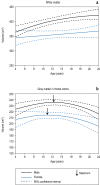Brain development during adolescence: neuroscientific insights into this developmental period
- PMID: 23840287
- PMCID: PMC3705203
- DOI: 10.3238/arztebl.2013.0425
Brain development during adolescence: neuroscientific insights into this developmental period
Abstract
Background: Adolescence is the phase of life between late childhood and adulthood. Typically, adolescents seek diversion, new experiences, and strong emotions, sometimes putting their health at serious risk. In Germany, for example, 62% of all deaths among persons aged 15 to 20 are due to traumatic injuries. Neuroscientific explanations have been proposed for typical adolescent behavior; with these explanations in mind, one can derive appropriate ways of dealing with adolescents.
Method: We selectively review pertinent articles retrieved from the PubMed database about the structural and functional development of the brain in adolescence.
Results: New findings in developmental psychology and neuroscience reveal that a fundamental reorganization of the brain takes place in adolescence. In postnatal brain development, the maximum density of gray matter is reached first in the primary sensorimotor cortex, and the prefrontal cortex matures last. Subcortical brain areas, especially the limbic system and the reward system, develop earlier, so that there is an imbalance during adolescence between the more mature subcortical areas and less mature prefrontal areas. This may account for typical adolescent behavior patterns, including risk-taking.
Conclusion: The high plasticity of the adolescent brain permits environmental influences to exert particularly strong effects on cortical circuitry. While this makes intellectual and emotional development possible, it also opens the door to potentially harmful influences.
Figures



Comment in
-
Mental health and psychological illness in adolescence.Dtsch Arztebl Int. 2013 Jun;110(25):423-4. doi: 10.3238/arztebl.2013.0423. Dtsch Arztebl Int. 2013. PMID: 23840286 Free PMC article. No abstract available.
-
Taking more time.Dtsch Arztebl Int. 2013 Oct;110(43):732. doi: 10.3238/arztebl.2013.0732a. Dtsch Arztebl Int. 2013. PMID: 24222792 Free PMC article. No abstract available.
-
Neuromolecular analogies.Dtsch Arztebl Int. 2013 Oct;110(43):732-3. doi: 10.3238/arztebl.2013.0732b. Dtsch Arztebl Int. 2013. PMID: 24222793 Free PMC article. No abstract available.
-
Temporal limitation and irreversibility of brain development.Dtsch Arztebl Int. 2013 Oct;110(43):733. doi: 10.3238/arztebl.2013.0733a. Dtsch Arztebl Int. 2013. PMID: 24222794 Free PMC article. No abstract available.
-
In reply.Dtsch Arztebl Int. 2013 Oct;110(43):733. doi: 10.3238/arztebl.2013.0733b. Dtsch Arztebl Int. 2013. PMID: 24222795 Free PMC article. No abstract available.
References
-
- Crone EA, Dahl RE. Understanding adolescence as a period of social-affective engagement and goal flexibility. Nature reviews. Neuroscience. 2012;13:636–650. - PubMed
-
- Steinberg L. Risk taking in adolescence: what changes, and why? Annals of the New York Academy of Sciences. 2004;1021:51–58. - PubMed
-
- Eaton DK, Kann L, Kinchen S, et al. Youth risk behavior surveillance—United States, 2005. Morbidity and mortality weekly report. Surveillance Summaries. 2006;55:1–108. - PubMed
-
- Statistisches Bundesamt. Unfälle, Gewalt, Selbstverletzung bei Kindern und Jugendlichen 2010. www.ec-destatic.de.
Publication types
MeSH terms
LinkOut - more resources
Full Text Sources
Other Literature Sources
Medical

